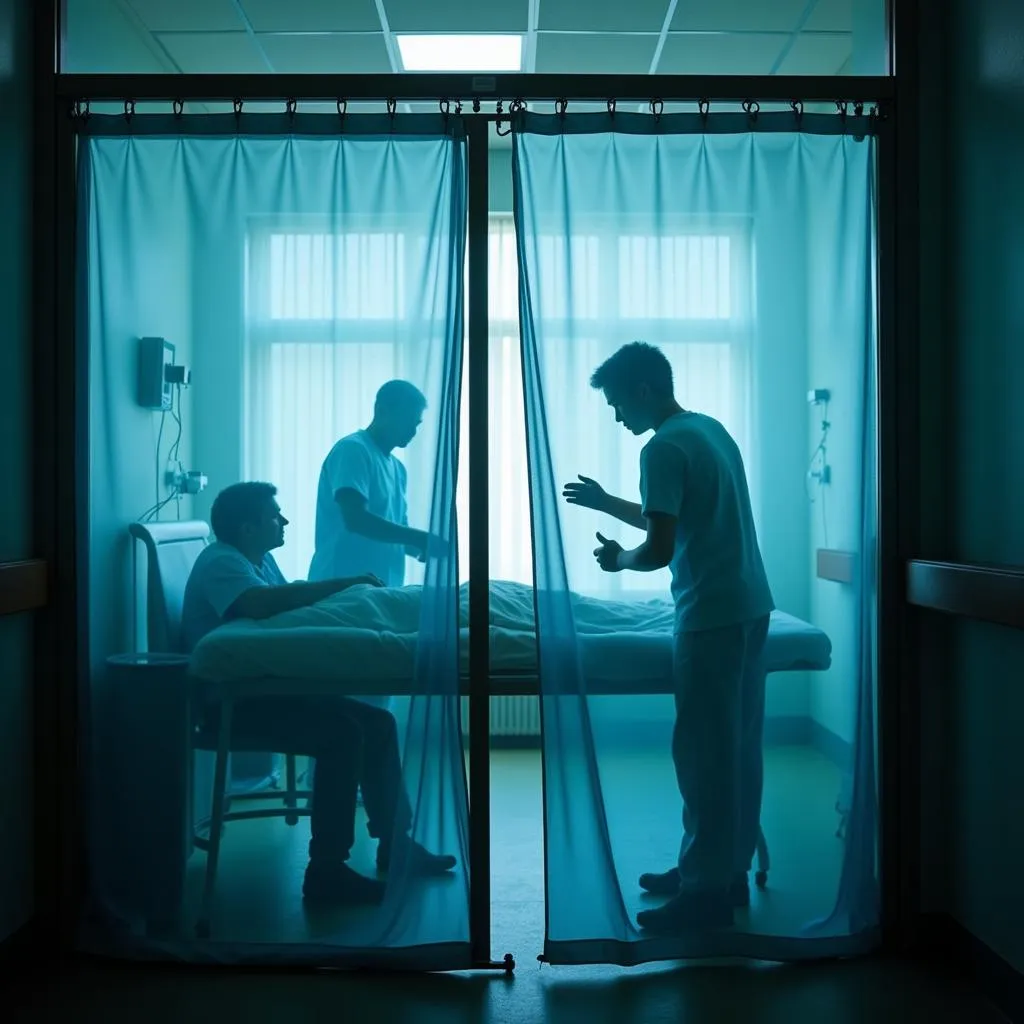Hospital Cubicle Curtains are an essential aspect of healthcare facilities, playing a crucial role in ensuring patient privacy and comfort. These curtains act as a physical barrier between patients in shared rooms, providing a much-needed sense of personal space and dignity. Beyond their practical function, hospital cubicle curtains contribute to the overall ambiance of a healthcare environment, impacting both patient well-being and the efficiency of medical staff.
The Multifaceted Role of Hospital Cubicle Curtains
While seemingly simple, hospital cubicle curtains fulfill several vital functions in a healthcare setting. Let’s delve into the key roles these curtains play:
Privacy and Dignity: A Fundamental Human Need
Hospital stays can be stressful and often involve procedures that compromise a patient’s sense of privacy. Cubicle curtains provide a visual and physical barrier, allowing patients to maintain their dignity during examinations, treatments, and personal care routines. This privacy is essential for reducing anxiety and fostering a sense of comfort during a vulnerable time.
 Patients receiving treatment behind a hospital cubicle curtain
Patients receiving treatment behind a hospital cubicle curtain
Infection Control: Preventing the Spread of Germs
Hospitals, by their nature, house a high concentration of germs. Cubicle curtains act as a barrier to help contain the spread of infections. The material used in these curtains is often treated with antimicrobial agents, further reducing the risk of cross-contamination between patients.
Creating a Calmer Environment: Reducing Noise and Visual Disturbances
Hospitals can be noisy and visually stimulating environments. Cubicle curtains help to absorb sound and minimize visual distractions, promoting a calmer and more restful atmosphere for patients. This is especially important for patients recovering from surgery or those who require isolation due to infectious diseases.
 Hospital room with cubicle curtains separating beds
Hospital room with cubicle curtains separating beds
Choosing the Right Hospital Cubicle Curtains
Selecting appropriate cubicle curtains involves considering several factors, including:
- Material: Curtains should be made from durable, easy-to-clean fabrics that meet fire safety standards.
- Antimicrobial Properties: Curtains treated with antimicrobial agents provide an added layer of protection against infections.
- Size and Configuration: Curtains should be appropriately sized to provide adequate privacy and fit the layout of the room.
- Design and Color: While functionality is paramount, the design and color of cubicle curtains can contribute to a more calming and aesthetically pleasing environment.
“Selecting cubicle curtains goes beyond simple aesthetics,” says Jane Doe, a leading hospital design consultant. “The right curtain choice contributes to patient well-being, infection control, and staff efficiency.”
Maintaining Hospital Cubicle Curtains: Hygiene is Paramount
Regular cleaning and maintenance are crucial to ensure the effectiveness of hospital cubicle curtains.
- Frequent Cleaning: Curtains should be cleaned regularly, following strict hygiene protocols to prevent the spread of germs.
- Inspection for Damage: Curtains should be inspected for tears, rips, or signs of wear and tear. Damaged curtains should be replaced immediately.
 Hospital staff cleaning cubicle curtains
Hospital staff cleaning cubicle curtains
Beyond Functionality: The Impact of Design
While functionality remains a priority, the design and aesthetics of hospital cubicle curtains should not be overlooked. Studies have shown that a pleasant and calming environment can positively impact patient recovery and well-being.
- Color Psychology: Soft, calming colors such as blue and green are often used in healthcare settings as they are believed to promote tranquility and reduce stress.
- Patterns and Textures: Subtle patterns and textures can add visual interest without being overwhelming.
“A well-designed healthcare space, including carefully chosen cubicle curtains, can contribute to a more positive patient experience,” adds Doe. “It’s about creating an environment that feels as comfortable and non-clinical as possible.”
Conclusion: Small Details, Big Impact
Hospital cubicle curtains, though seemingly minor details, play a significant role in creating a healthcare environment that prioritizes patient privacy, comfort, and safety. By carefully selecting and maintaining these curtains, healthcare facilities can contribute to a more positive patient experience and a more efficient work environment for medical staff.
FAQs about Hospital Cubicle Curtains
1. How often should hospital cubicle curtains be cleaned?
Hospital cubicle curtains should be cleaned regularly, ideally on a weekly basis or more frequently if visibly soiled or in high-touch areas.
2. What are the benefits of antimicrobial cubicle curtains?
Antimicrobial curtains help to inhibit the growth of bacteria and other microorganisms, reducing the risk of healthcare-associated infections.
3. Can cubicle curtains be customized for different hospital departments?
Yes, cubicle curtains can be customized in terms of size, color, and design to meet the specific needs of different hospital departments.
4. What are some tips for choosing the right cubicle curtain track system?
When choosing a track system, consider durability, ease of use, and compatibility with the chosen curtain material.
5. Are there fire-retardant cubicle curtains available?
Yes, it is essential to choose cubicle curtains that meet fire safety standards and are made from fire-retardant materials.
For further information or assistance with selecting the right hospital cubicle curtains for your facility, please contact us at [Phone Number], email us at [Email Address], or visit us at [Hospital Address]. Our dedicated customer service team is available 24/7 to assist you.